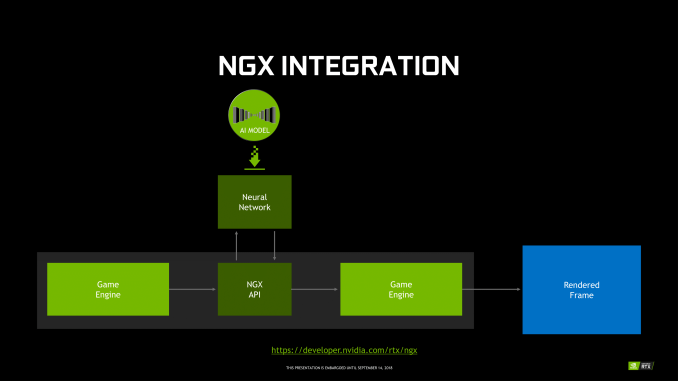The NVIDIA Turing GPU Architecture Deep Dive: Prelude to GeForce RTX
by Nate Oh on September 14, 2018 12:30 PM ESTUnpacking 'RTX', 'NGX', and Game Support
One of the more complicated aspects of GeForce RTX and Turing is not only the 'RTX' branding, but how all of Turing's features are collectively called the NVIDIA RTX platform. To recap, here is a quick list of the separate but similarly named groupings:
- NVIDIA RTX Platform - general platform encompassing all Turing features, including advanced shaders
- NVIDIA RTX Raytracing technology - name for ray tracing technology under RTX platform
- GameWorks Raytracing - raytracing denoiser module for GameWorks SDK
- GeForce RTX - the brand connected with games using NVIDIA RTX real time ray tracing
- GeForce RTX - the brand for graphics cards
For NGX, it technically falls under the RTX platform, and includes Deep Learning Super Sampling (DLSS). Using a deep neural network (DNN) specific to the game and trained on super high quality 64x supersampled images, or 'ground truth' images, DLSS uses tensor cores to infer high quality antialiased results. In the standard mode, DLSS renders at a lower input sample count, typically 2x less but may depend on the game, and then infers a result, which at target resolution is similar quality to TAA result. A DLSS 2X mode exists, where the input is rendered at the final target resolution and then combined with a larger DLSS network.
Fortunately, GFE is not required for NGX features to work, and all the necessary NGX files will be available via the standard Game Ready drivers, though it's not clear how often DNNs for particular games would be updated.
In the case of RTX-OPS, it describes a workload for a frame where both RT and Tensor Cores are utilized; currently, the classic scenario would be with a game with real time ray tracing and DLSS. So by definition, it only accurately measures that type of workload. However, this metric currently does not apply to any game, as DXR has not yet released. For the time being, the metric does not describe performance any publicly available game.
In sum, then the upcoming game support aligns with the following table.
| Planned NVIDIA Turing Feature Support for Games | |||||
| Game | Real Time Raytracing | Deep Learning Supersampling (DLSS) | Turing Advanced Shading | ||
| Ark: Survival Evolved | Yes | ||||
| Assetto Corsa Competizione | Yes | ||||
| Atomic Heart | Yes | Yes | |||
| Battlefield V | Yes | ||||
| Control | Yes | ||||
| Dauntless | Yes | ||||
| Darksiders III | Yes | ||||
| Deliver Us The Moon: Fortuna | Yes | ||||
| Enlisted | Yes | ||||
| Fear The Wolves | Yes | ||||
| Final Fantasy XV | Yes | ||||
| Fractured Lands | Yes | ||||
| Hellblade: Senua's Sacrifice | Yes | ||||
| Hitman 2 | Yes | ||||
| In Death | Yes | ||||
| Islands of Nyne | Yes | ||||
| Justice | Yes | Yes | |||
| JX3 | Yes | Yes | |||
| KINETIK | Yes | ||||
| MechWarrior 5: Mercenaries | Yes | Yes | |||
| Metro Exodus | Yes | ||||
| Outpost Zero | Yes | ||||
| Overkill's The Walking Dead | Yes | ||||
| PlayerUnknown Battlegrounds | Yes | ||||
| ProjectDH | Yes | ||||
| Remnant: From the Ashes | Yes | ||||
| SCUM | Yes | ||||
| Serious Sam 4: Planet Badass | Yes | ||||
| Shadow of the Tomb Raider | Yes | ||||
| Stormdivers | Yes | ||||
| The Forge Arena | Yes | ||||
| We Happy Few | Yes | ||||
| Wolfenstein II | Yes | ||||











111 Comments
View All Comments
Wwhat - Wednesday, October 17, 2018 - link
What the article ignores is that ray tracing went through a long revolution, and one of the findings at one point for example was that triangles weren't covering the need for advanced ray-tracing, after which things like NURBS were thrown into the mix.My point being that you would think the RT for gaming development would not start from point A and slowly meander to all the evolutionary steps with constant hardware updates. But it's not clear at the moment if the Nvidia team is 'keeping it simple' for now in their package, or if that's just how it is presented for easy presentation to the crowd.